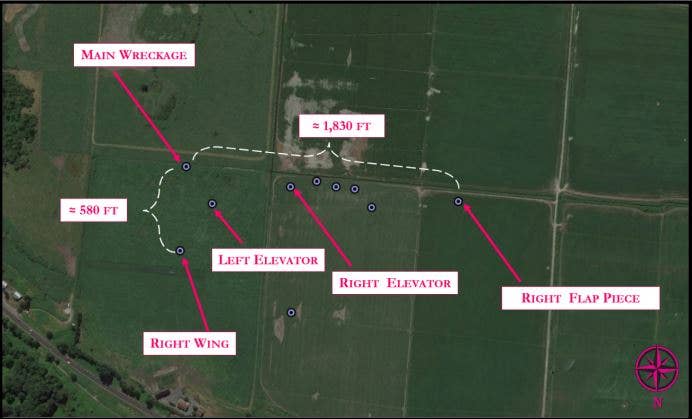NTSB Releases Details of Caravan Crash That Killed 4
Inflight break up confirmed in turboprop that was intended for Raisbeck flight testing.

The wreckage debris field from the November 18 crash of a 2021 Cessna 208B EX Caravan in Snohomish, Washington. [Credit: NTSB]
A 2021 Cessna 208B EX Caravan was downed in Snohomish, Washington, after it experienced an inflight breakup during test flight maneuvers last month, according to the National Transportation Safety Board (NTSB).
The NTSB confirmed the details of the November 18 accident that killed four people in a preliminary investigation report that it released Sunday.
The aircraft, identified as Cessna 208B EX Caravan, N2069B, was on lease to Raisbeck Engineering, a Seattle-based company that specializes in aircraft modification systems for business and commercial aircraft to improve aircraft performance and efficiency.
According to the NTSB, Raisbeck Engineering holds the supplemental type certificate (STC) for an aerodynamic drag reduction system (DRS) on the Cessna 208B.
The purpose of the flight was to test the ability to expand the applicability of that DRS to the Cessna 208B EX model. QuickSilver Aero, another Seattle company, was contracted to provide instrumentation support for the flight test program.
Lead Up to the Accident
According to the NTSB, on November 15, the aircraft began a series of test flights that were conducted over multiple days with several test pilots.
The first day’s flights consisted of three segments totaling 1.1 hours. The flights included pilot familiarity flight and a ferry flight to have the airplane’s weight and balance performed.
On the second day, the aircraft was flown to establish baseline data for future test flights for both mid center-of-gravity (CG) cruise flight and forward CG stall speeds. The flights equated to a total of 4.6 hours of flight time.
The day prior to the accident, two more test flights were performed. The first flight, totaling 1.2 hours, was testing aft CG static stability. The last flight of the day ended short, totaling 1.4 hours, with only about half of the planned test maneuvers completed because a crewmember in the back of the airplane was feeling ill.
Day of the Accident
The purpose of the accident flight was to complete the test maneuvers from the day prior, which consisted of testing the aircraft's stall performance.
The radar track of the Caravan shows the aircraft took off from Renton Municipal Airport (KRNT) around 9:25 a.m. and headed north. The conditions were VFR and the airplane continued in a gradual climb to about 9,500 feet msl, and began a series of turns and other maneuvers. The airplane flew for about 45 minutes, varying in altitude between about 6,500 feet to 10,275 feet. At 10:17 the track data indicated the airplane was climbing to an altitude of 9,700 feet and turning to the left.
According to the radar data, the aircraft made a near 360-degree turn and then at 10:19:06, there was a sharp 180-degree left-turn. The track continued west until the last recorded hit at 10:19:18.
During the last 12 seconds the track indicated that the airplane’s descent rate exceeded 14,000 fpm and gradually lessened to 8,700 fpm at the last report. The main wreckage was located about 2,145 feet east of the last recorded track data.
The pilot who had flown the test flights the day before the accident reviewed the radar track information. He told investigators that prior to the accident, it was likely the flight crew were conducting the second-to-last maneuver on the card which specified: 96 kts indicated airspeed; flaps in landing configuration; 930 ft-lbs of torque; propeller rpm fully forward; and accelerated 30-degree bank to the left.
Accident Details
Several witnesses on the ground reported seeing a white plume of smoke when they observed the airplane break into pieces. A security camera recorded a low-quality image of the airplane rotating about its longitudinal axis in nose-low attitude.
According to information recorded by FlightAware.com, the aircraft entered into a series of turns, climbs, and descents with airspeed fluctuations before it plunged to the ground. The flight had been in the air for approximately 55 minutes.
The main wreckage came down in an agricultural field 2 nm east of Harvey Field (S43). The NTSB's initial investigation revealed that the right wing of the 2021 Cessna 208B was found some 200 yards from the main fuselage of the aircraft, indicating it had separated from the airframe before impact. The left-wing flap was attached to the main wing and in the flap was in the retracted position.
The main wreckage—consisting of the engine, cockpit, cargo pod, cabin, vertical stabilizer, and rudder—was partially consumed by fire. The right-wing strut separated from the fuselage attachment point, but remained attached to the wing. The right flap was separated into numerous pieces and scattered among the debris field.
After the accident, Hal Chrisman, president of Raisbeck Engineering, noted the aircraft “… at the time of the crash was under the command of two highly-experienced test pilots, both with over 10,000 flight hours. The purpose of the flight was to collect baseline aircraft performance data. The entire crew of four also included a flight test director and an instrumentation engineer.”
Chrisman stated the flight was conducted prior to the installation of a Raisbeck modification, which is “standard industry practice that allows aviation engineering firms to establish baseline aircraft performance under a highly structured flight profile to later measure and compare the change in performance after any proposed modifications are installed. The aircraft was in this initial testing phase and had not yet been modified in any way.”

Sign-up for newsletters & special offers!
Get the latest FLYING stories & special offers delivered directly to your inbox






